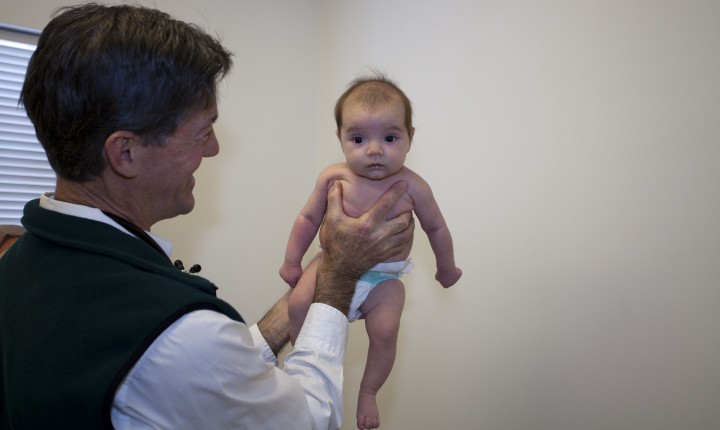When Kevin Mullin, Executive Director of Development of Inner City Health Center, first walked through its doors for his job interview six months ago, he knew this wasn’t just any routine employer.

 “When you walk in and you see the facilities and you see the people who are receiving the help that they need and most importantly, the staff, the people who work here are so amazing,” he says. “It was just obvious that it was a special place. There’s a feeling that you get.”
“When you walk in and you see the facilities and you see the people who are receiving the help that they need and most importantly, the staff, the people who work here are so amazing,” he says. “It was just obvious that it was a special place. There’s a feeling that you get.”
For the past 30 years, Inner City Health Center has built a reputation as Denver’s premier organization providing clinical health services for the uninsured and underinsured. The center provides physical, mental health, dental, and spiritual care, with a comprehensive medical approach. Inner City Health Center began as an idea shared by a husband and wife team: Jan Williams, a counselor, and Dr. Bob Williams were already active in medical mission trips as a reflection of their Christian faith, but they felt a sense of needing to do more. They were soon joined by Dr. Duane Claassen, a colleague of Dr. Williams, who had been practicing in a small clinic in rural Mississippi. The Center opened in Five Points in 1983 and its campus is now on York Street.
Eighty percent of patients are uninsured or underinsured and all pay some portion of their bill on a sliding scale, depending on qualifiers.
As this cornerstone of Denver’s community safety net enters into its next chapter, leadership personnel at the Center say the next 30 years is expected to be more complex and dynamic than ever, and readers of Modern Gladiator magazine can definitely help with a few key elements to support the Center’s work.

Increased traffic
 Currently, the Inner City Health Center serves about 25,000 people a year, and growth in patient traffic is consistently around 10 percent year over year. Medical Director Dr. Douglas Fairbairn says he’s seeing some very different trends now in who utilizes their services, compared to even a decade ago.
Currently, the Inner City Health Center serves about 25,000 people a year, and growth in patient traffic is consistently around 10 percent year over year. Medical Director Dr. Douglas Fairbairn says he’s seeing some very different trends now in who utilizes their services, compared to even a decade ago.
“It used to be the poor were medically underserved,” he says, “but now it is a complicated fabric defining who is medically underserved due to high-deductible insurance policies or insurance that doesn’t cover any preventative healthcare services, which people then have to pay for out of pocket. We are seeing much more traffic across all social and economic levels.”
Even more interesting, Dr. Fairbairn says the increasingly fractured insurance landscape is propelling younger and younger patients through the doors.
 The increase in low premium, high-deductible catastrophic policies are the reason behind it. Young couples who get pregnant or want basic healthcare services must pay out of pocket, and are increasingly coming to Inner City Health Center for that care.
The increase in low premium, high-deductible catastrophic policies are the reason behind it. Young couples who get pregnant or want basic healthcare services must pay out of pocket, and are increasingly coming to Inner City Health Center for that care.
Affordable Care Act
Dr. Fairbairn and Chief Executive Officer Kraig Burleson say the Affordable Care Act is having a major influence in shaping their vision for the facility’s future, as some of Denver’s 800,000 uninsured people are put on Medicaid rolls and/or obtain private insurance. They anticipate an uptick in patients trying to access their services as a result, and are formulating a plan to accommodate those people and the conversion of existing patients to private insurance.
“We are going to start taking private carriers too because an uninsured patient who has obtained private coverage through the ACA, we want to make sure there is continuity of care,” says Burleson.
As part of its core mission to providing accessible healthcare services to all stakeholders, leadership personnel say it is vital to get plans in place now to be ready as the patient traffic trends upward at a quicker pace.
Short and long-term needs, and how gladiators can help

Burleson, Fairbairn, and Mullin all say the perennial misconception that the center is part of the public healthcare system continues to be an issue. “We are not,” says Burleson. “We don’t get any direct federal funding or state dollars.”
With that in mind, the Center says it needs all the manpower and dollars it can get to support several upcoming initiatives, events, and needs. These include:
- The purchase of an ultrasound machine, which is estimated to cost $45,000. The previous machine stopped working and the Center currently leases the machine in use.
- A conversion of dental radiology to digital, which is estimated to cost $55,000. Digital radiology will provide staff with much clearer images with which to diagnose and treat diseases.
- The Center needs dollars to reconfigure its existing space to accommodate more patients by adding two more medical exam rooms and four more dental chairs.
- JAZZED Fundraiser, October 10, 2014: This main fundraiser for the Center features Denver jazz icon Hazel Miller, who has accessed services at Inner City Health Center and says the staff saved her life. Miller has enthusiastically offered to help the center in its fundraising efforts; this event at The Cable Center is just a part of her work on its behalf.
- Campus expansion and capital campaign. Currently, studies are being done to map out a campus expansion and identify the dollars needed to utilize an existing building on campaign for a fitness center and behavioral health suites. A possible capital campaign will be launched in 2015 to make these improvements and expand the Center’s scope of services.
With the community’s help, he’s confident Inner City Health Center can negotiate the current healthcare landscape.
Employees and volunteers are also participating in the Colfax Marathon this year. All modern gladiators are also encouraged to attend the center’s “Heart Health Event” on its campus to learn more. That event is on May 31 and is free to attend.
 Mullin says with the community’s help, he’s confident Inner City Health Center can negotiate the current healthcare landscape, which is rapidly changing.
Mullin says with the community’s help, he’s confident Inner City Health Center can negotiate the current healthcare landscape, which is rapidly changing.
“As a private, independent, locally-governed non-profit organization, we have the flexibility to be nimble,” he says. “We focus on the things that we can control: making sure people get great healthcare, affordably, telling our story, letting people know what we do here and how they can help.”
Related Posts
« Fisker Karma EV: A Sports Car With a “Soul?” 7 Essential Family Travel Gadgets »









